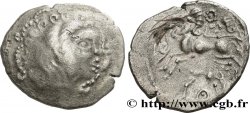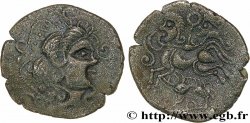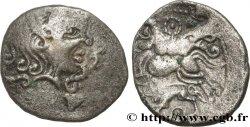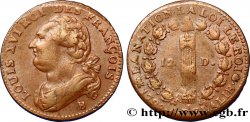v41_1583 - VENETI (Area of Vannes) Quart de statère d'argent, classe I
MONNAIES 41 (2009)
Starting price : 450.00 €
Estimate : 900.00 €
Realised price : 530.00 €
Number of bids : 4
Maximum bid : 674.00 €
Starting price : 450.00 €
Estimate : 900.00 €
Realised price : 530.00 €
Number of bids : 4
Maximum bid : 674.00 €
Type : Quart de statère d'argent, classe I
Date: c. 60-50 AC.
Mint name / Town : Vannes (56)
Metal : silver
Diameter : 12,5 mm
Orientation dies : 8 h.
Weight : 1,54 g.
Rarity : R3
Coments on the condition:
Flan un peu court mais frappe centrée et types relativement complets. Reliefs un peu émoussés, mais encore bien identifiables. Patine grise, légèrement poreuse
Catalogue references :
Predigree :
Ce quart de statère provient de la trouvaille de Jersey dit “trouvaille du Catillon”. Il fut revendu par Chris Rudd
Obverse
Obverse legend : ANÉPIGRAPHE.
Obverse description : Tête à droite, les cheveux en grosses mèches ; décors en chevrons derrière la tête.
Reverse
Reverse legend : ANÉPIGRAPHE.
Reverse description : Cheval androcéphale, bridé à droite ; au-dessus, l'aurige tient une hampe ; sous le cheval, petit personnage couché à droite.
Commentary
Ce quart de statère est seulement la seconde monnaie divisionnaire en argent ou de billon des Vénètes que nous proposions. En admettant que le classement des statères soit à appliquer par extension aux quarts de statères, cet exemplaire avec cheval androcéphale à droite appartient d’office à la classe I et le motif entre les jambes du cheval est obligatoirement un petit personnage couché à droite (?).
Ce type semble particulièrement rare ; toutes les publications depuis 1953 jusqu’au récent Nouvel Atlas semblent n’utiliser qu’un seul exemplaire (maintenant conservé à Rennes).
This quarter stater is only the second silver or billon divisional coin of the Veneti that we have proposed. Assuming that the classification of staters is to be applied by extension to quarter staters, this example with an androcephalic horse on the right automatically belongs to class I and the motif between the horse's legs is necessarily a small figure lying on the right (?). This type seems particularly rare; all publications from 1953 until the recent New Atlas seem to use only a single example (now kept in Rennes)
Ce type semble particulièrement rare ; toutes les publications depuis 1953 jusqu’au récent Nouvel Atlas semblent n’utiliser qu’un seul exemplaire (maintenant conservé à Rennes).
This quarter stater is only the second silver or billon divisional coin of the Veneti that we have proposed. Assuming that the classification of staters is to be applied by extension to quarter staters, this example with an androcephalic horse on the right automatically belongs to class I and the motif between the horse's legs is necessarily a small figure lying on the right (?). This type seems particularly rare; all publications from 1953 until the recent New Atlas seem to use only a single example (now kept in Rennes)








 Report a mistake
Report a mistake Print the page
Print the page Share my selection
Share my selection Ask a question
Ask a question Consign / sell
Consign / sell
 Full data
Full data















